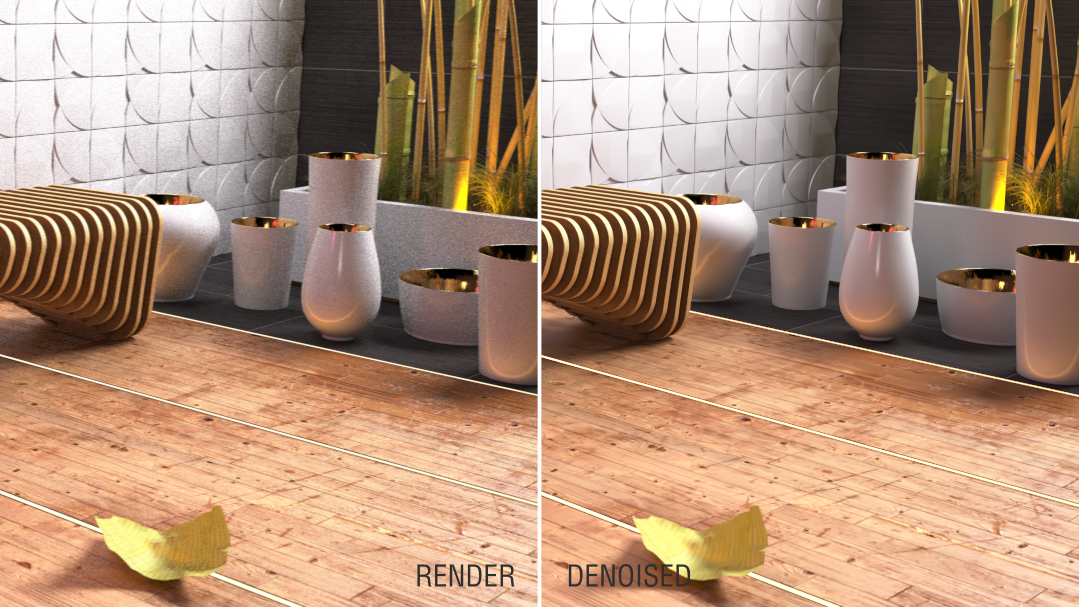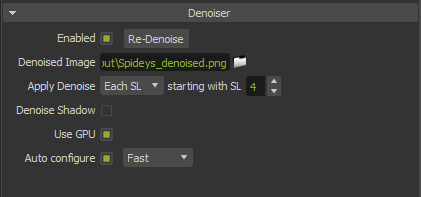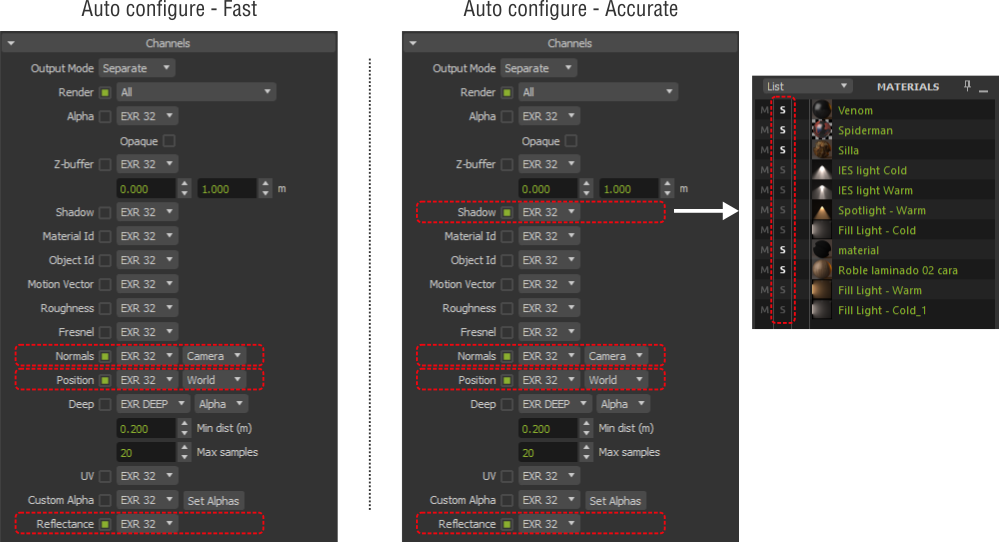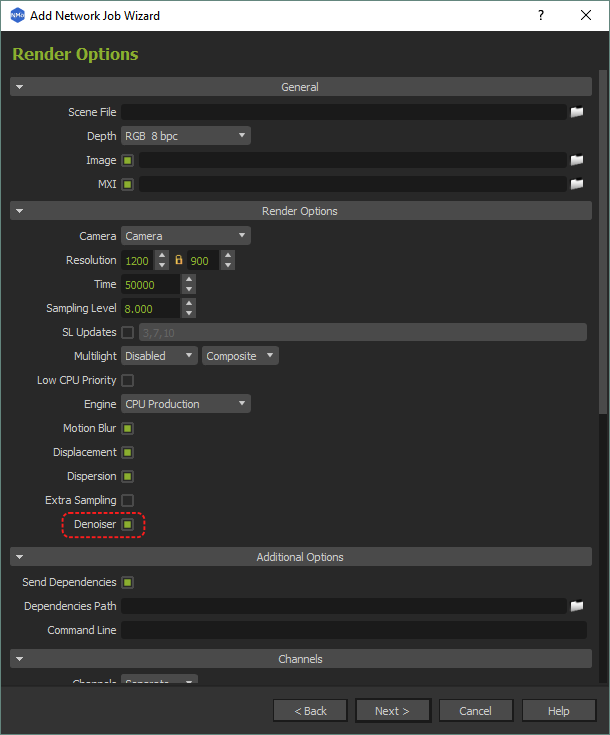

The denoiser included in Maxwell is based on Innobright's Altus technology.
Maxwell developers team, in collaboration with the Innobright team, has integrated Altus Denoiser inside Studio, Maxwell Render and plugins so you can enjoy the power of Altus and Maxwell together.
Denoiser integration is offered as a free solution for all Maxwell customers. No extra license is required.
The denoiser calculation is a biased process applied over unbiased Maxwell renders. The higher the sampling level of the render, the more accurate the denoiser solution will be and the less bias it will introduce.
You can launch a render with Denoiser either from Maxwell Studio, Maxwell Render or any plugin. You will find very similar options on all platforms.
In Studio you can find Denoiser options under Render Options > Scene tab > Denoiser section.
In Maxwell, it is in Render Options panel > Denoiser, right below Scene section.
In plugins, its location may change from one to the other but it should be close to main render options.

Regardless of where you use the denoiser, you will find the same options:
| Enabled | Activates or deactivates denoiser calculation for the next render. |
| Denoised Image | Here you can specify the path, name and format of the denoised image. |
| Apply Denoise | In this drop-down menu you can choose to calculate the denoised image at each SL starting with the one set in the spinbox (default option) or only at the end of the render. |
| Denoise Shadow | This option allows to additionally denoise shadow channel (only available with "Auto configure" set to "Accurate") |
| Use GPU | If on, the denoised image will be calculated using the GPU (much faster usually), if not it will use CPU |
| Auto Configure | If activated, this option will set all the required channels and options automatically; it comes in two flavours: Fast and Accurate (explained below). |
| Re-Denoise (only in Maxwell Render) | This option allows to redo denoise calculation after you have made changes to Multilight sliders, so you can produce a denoised image with the new light configuration. |
It's important to understand that the Denoiser needs to launch two renders and benefits from some extra channels so, when you activate the denoiser, render routine changes in order to get this information.
Don't worry, everything is done under the hood automatically and at the end, you will get the work of both renders combined in a merged mxi plus the denoised image.
You can get information the progress of both renders in Render Progress and Render Info toolbars and in Console:

There are two options to show denoised image:
![]()

You won't get a denoised image until the end of the process.
This method is less interactive and is only recommended if you already know which SL your scene will need to get a good result, for network renders, or animations.
Please, note that if you stop the render before the second pass has started rendering, you won't get a denoised image as the Denoiser won't have enough information (the second pass) to work with. |

The two passes are stored in a temporal folder; their names are based on the output name of the mxi following this pattern: mxiname_render1.mxi and mxiname_render2.mxi. The folder depends on the operating system but is printed in Maxwell Render Console during the render process after a blue DEBUG message like this: DEBUG: - Modifying Scene for Denoise values (MXI file: C:/Users/<username>/AppData/Local/Temp/maxwellrendertmp/test folders_render2.mxi) In Windows they are stored under: C:/Users/<username>/AppData/Local/Temp/maxwellrendertmp/ In MacOS they are stored in a random folder under /var/folders/ |
Regardless the render engine you use, the Denoiser is capable of running on GPU, with Nvidia, AMD and Intel hardware; it works with CUDA (Nvidia) and also can work using OpenCL either in GPU (Nvidia, AMD or Intel) or CPU.
The default option is GPU as it is usually much faster; the Denoiser will first try to use CUDA, if it doesn't find a compatible card, it will fallback to OpenCL GPU (usually with AMD and Intel cards) and then OpenCL with CPU.
This would be minimum system requirements for Denoiser:
In the case you get an error message when using CPU about OpenCL ICDs, it means Maxwell cannot find valid OpenCL drivers installed on your machine; usually, those drivers are included with your graphics card drivers, so I would try updating the drivers to the latest. If that doesn't help, it will probably be solved by installing this Intel's OpenCL runtime package: Windows: opencl_runtime_18.1_x64_setup.msi Linux: opencl_runtime_18.1.0.013.tgz This could also solve the error "OpenCL exception" shown when using the latest AMD processors. |
The Denoiser can make good use of extra channels in order to preserve features and details of the image, but it has some special requirements for the channels. Auto configure option sets everything up for you.
Both options, Fast and Accurate, calculate de denoised image with the same quality but activate different options under the hood that may affect render time and the final result in different ways.
Let's see the differences between Fast (default) and Accurate:

When you activate Auto configure, you won't see these channels actually active in the interface, but they will be activated internally at render time.
The main difference between Fast and Accurate is that Fast doesn’t use shadow channel making it almost twice faster than accurate, but as it relies on fewer channels, it could be less accurate.
On the other hand, Accurate method marks Shadow option in all materials except for emitters, so they show in shadow channel and activates this channel. The render will be slower but will count on shadow channel information which can make the denoiser process more accurate.
If you don't want to use any of the two Auto configure options and set everything up manually, you have to take into account that the Denoiser needs the following to work correctly:
This option is only available in Maxwell Render. It was added to the interface in order apply Multilight changes to the denoised image after the render has finished.
Normally you will be able to change Multilight sliders and they will affect not-denoised image as always; if you want to get a denoised version of it, you only have to click this button and Maxwell will apply the changes to both passes and redo the denoiser process with the new light configuration.
The Network System can handle renders with Denoiser.
You will find a new checkbox in the Add Network Job Wizard to turn it on or off.

| Regardless of what was set in the scene, when launching a network job with Denoiser, it will always run in "At end" mode. |
Single mode: If the render is computed in single mode so each node runs a different frame (regardless it is an animation or batch render), the denoised image will be computed by the nodes, the same way as when it is rendered in Maxwell Render; this means each node will run the two passes and compute the denoised image.
Cooperative mode: in this case, as there are at least two nodes rendering the same frame, there is no need for the nodes to run the two passes, so the nodes will run normal renders (with the required extra channels and settings) and at the end, the manager will collect all the mxi files, merge them until there are only two left, and compute the denoised image from those two mxi files. So in this case, the computer running manager is the one that is going to calculate the denoised image.
| mximerge -folder:"folder containing the mxi files of the same frame" -coopdenoiser:"output path and name of the denoised image" -target:"path and name of the merged mxi file" |
You have to execute this command in the installation folder of Maxwell Render, where you will find mximerge executable file. Please, notice there is a space between the path and the next command, but not after the colon.
We will try to solve these issues or remove these limitations as soon as possible. Please, be patient.